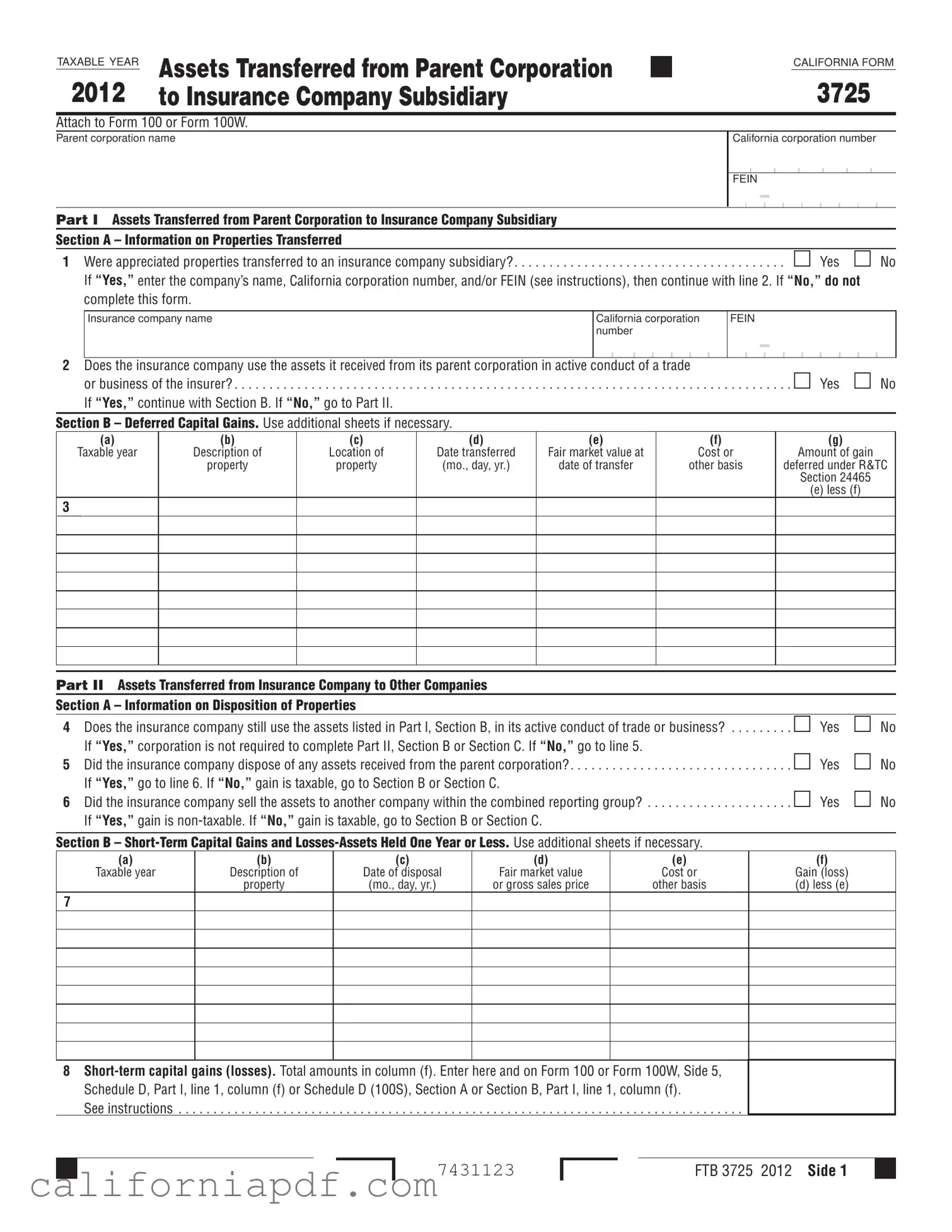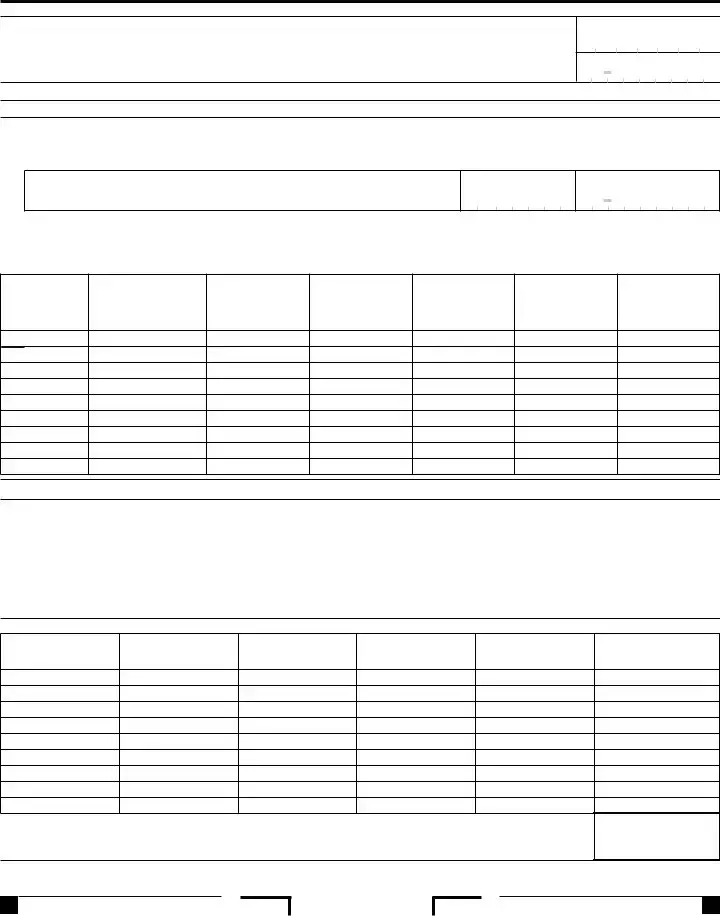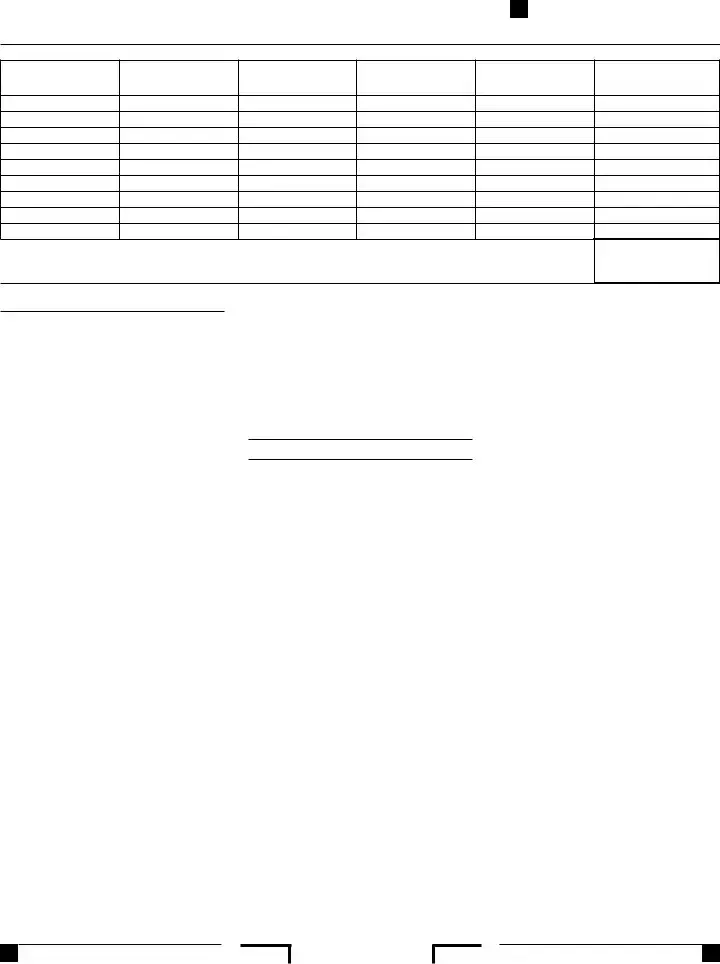Section C – Long-Term Capital Gains and Losses-Assets Held More Than One Year. Use additional sheets if necessary.
(a) |
(b) |
(c) |
(d) |
(e) |
(f) |
Taxable year |
Description of |
Date of disposal |
Fair market value |
Cost or |
Gain (loss) |
|
property |
(mo., day, yr.) |
or gross sales price |
other basis |
(d) less (e) |
9
0 Long-term capital gains (losses). Total amounts in column (f). Enter here and on Form 100 or Form 100W, Side 5, Schedule D, Part II, line 5, column (f) or Schedule D (100S), Section A or Section B, Part II, line 4, column (f).
See instructions . . . . . . . . . . . . . . . . . . . . . . . . . . . . . . . . . . . . . . . . . . . . . . . . . . . . . . . . . . . . . . . . . . . . . . . . . . . . . . . . .
General Information
A Purpose
Use form FTB 3725, Assets Transferred from Parent Corporation to Insurance Company Subsidiary, to track the assets transferred from a parent corporation to an insurance company subsidiary. In addition, use this form to figure capital gains (losses) if the parent corporation transferred assets to an insurance company subsidiary beginning on or after June 23 2004.
California Revenue and Taxation Code (R&TC) Section 24465 provides that when a parent corporation transfers appreciated property to an insurance company subsidiary, the gain is deferred if the property transferred to the insurer is used in the active conduct of
a trade or business of the insurer. The gain must be recognized as income if any of the following apply:
•The transferred property is no longer owned by an insurer in the taxpayer’s commonly controlled group (or a member of the taxpayer’s combined reporting group).
•The property is no longer used in the active conduct of the insurer’s trade or business (or the trade or business of another member in the taxpayer’s combined reporting group).
•The holder of the property is no longer held by an insurer in the commonly controlled group of the transferor (or a member of the taxpayer’s combined reporting group).
R&TC Section 24465 applies to transactions entered into on or after June 23, 2004.
B Definitions
1.Appreciated property – Appreciated property means property whose fair market value (FMV), as of the date of the transfer, exceeds its adjusted basis as of that date.
2.Commonly controlled group – Commonly controlled group exists when stock possessing more than 50% of the voting power is owned, or constructively owned,
by a common parent corporation (or chains of corporations connected through the common parent) or by members of the same family, see R&TC Section 25105. Also, a commonly controlled group includes corporations that are stapled entities,
see R&TC Section 25105(b)(3). Special rules are provided in R&TC Section 25105 for partnerships, trusts, and transfers of voting power by proxy, voting trust, written shareholder agreement, etc.
Speciic Line Instructions
Part I – Assets Transferred from Parent Corporation to Insurance Company Subsidiary
Section A – Information on
Properties Transferred
Line – Enter the insurance company’s California corporation number or federal employer identification number (FEIN). If the insurance company does not have one of these numbers, enter “not applicable” and continue with line 2.
Section B – Deferred Capital Gains
Line 3, column (b) – Description of property. Describe the assets the parent corporation transferred to an insurance company subsidiary.
Line 3, column (e) – Fair market value at date of transfer. FMV is the price that the property would sell for in the open market.
Line 3, column (f) – Cost or other basis. In general, the cost or other basis is the cost of the property plus purchase commissions and improvements minus depreciation, amortization, and depletion. Enter the cost or adjusted basis of the asset for California purpose.
Part II – Assets Transferred from Insurance Company to Other Companies
Section B – Short-Term Capital Gains and Losses- Assets Held One Year or Less and
Section C – Long-Term Capital Gains and Losses-Assets Held More Than One Year
Report short-term or long-term capital gains (losses) based on the length of time the parent corporation held the assets.
Line 7 and Line 9, column (b) – Description of property. Describe the assets that the insurance company sells to another company; or the transferred assets that the insurance company does not use in its active trade or business.
Line 7 and Line 9, column (d) – Fair market value or gross sales price. Enter the FMV of the assets as of the date that the insurance company no longer uses the assets in its active trade or business. Or, enter the gross sales price of the assets if the insurance company sells the assets to another company.
Line 8 – Short-term capital gains (losses). Total amounts in column (f). Enter total short-term capital gains (losses) here and on Form 100 or Form 100W, Side 5, Schedule D, Part I, line 1, column (f) or Schedule D (100S), Section A or Section B, Part I, line 1, column (f). Write on Schedule D, under column (a) Description of property: “FTB 3725” and attach a copy of form FTB 3725 to the tax return.
Line 0 – Long-term capital gains (losses). Total amounts in column (f). Enter total long-term capital gains (losses) here and on Form 100 or Form 100W, Side 5, Schedule D, Part II, line 5, column (f) or Schedule D (100S), Section A or Section B, Part II, line 4, column (f). Write on Schedule D, under column (a) Description of property: “FTB 3725” and attach a copy of form FTB 3725 to the tax return.


